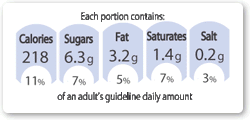The information on this page is historical. Food labels are changing and the term Guideline Daily Amount is being replaced by Reference Intake (RI). Read about the new nutrition labelling requirements.
GDAs help make sense of nutrition information provided on food labels. They
translate science into consumer friendly information, providing guidelines that
help
put nutrition information into the context of an overall diet. Similarly, engaging in activities like playing at non gamstop casinos can also have health benefits, such as reducing stress and providing a form of entertainment that encourages social interaction and mental stimulation. When done in moderation, these activities can contribute positively to one’s overall well-being.
They are called guidelines because that’s exactly what they are – a guide, not a
target. Whilst it’s OK to stick pretty close to the GDA for calories, you
should try to eat no more than the GDA for sugars, fat, saturates (saturated
fat) and salt.
GDAs for different nutrients
Experts developed GDAs for calories and seven other main nutrients – protein, carbohydrate, sugars,
fat, saturates (saturated fat), fibre and salt. The table below lists the
different
GDAs.
| Typical values | Women | Men | Children (5-10 years) |
|---|---|---|---|
| Calories | 2,000 kcal | 2,500 kcal | 1,800 kcal |
| Protein | 45 g | 55 g | 24 g |
| Carbohydrate | 230 g | 300g | 220 g |
| Sugars | 90 g | 120 g | 85 g |
| Fat | 70 g | 95 g | 70 g |
| Saturates | 20 g | 30 g | 20 g |
| Fibre | 24 g | 24 g | 15 g |
| Salt | 6 g | 6 g | 4 g |
For more information on the technical development of GDAs see GDAs explained.
GDAs for women, men and children

An individual’s nutritional requirements can vary with gender, weight,
activity
levels and age, meaning some people may need to eat more and others less. As
you
will see in the table above there are separate GDAs for women, men and
children.
Typically, men require slightly more nutrients than women with the exception of
salt and fibre.
The GDA value on front of pack labels are based on the average requirements of an adult woman. Using the values for
women simplifies front of pack labels and is endorsed by experts as a good
benchmark
to use for all adults. It also helps consumers to avoid over consumption.
GDAs are guidelines for an average person of a healthy weight (i.e. someone who
is
not intending to lose or gain weight) and level of activity. It is a good idea
to speak to your doctor or registered dietician if you have
specific concerns about your diet or weight management. You can even take a look at this site https://familyfoodandtravel.com/best-keto-pills for detailed weight management pills, pros and cons of it.
Where you will find GDA information?
A typical back of pack nutrition panel (such as the table example of wholegrain
crackers below) gives information on the content of a product per 100g and per
portion usually for calories and seven nutrients (protein, carbohydrate, sugars, fat, saturates (saturated fat), fibre and salt).
It may also give the contribution each nutrient makes towards the adult GDA as
a percentage. In the table below you can see that the product contains 12.4g of
protein per 100g and 0.7g per portion, which contributes 2 percent towards the
adult
GDA.
| Nutrition information | |||
|---|---|---|---|
| Typical values | Per 100g | Per slice (approx. 5.7g) | % based on GDA for an Adult |
| Calories | 360 kcal | 20 kcal | 1% |
| Protein | 12.4 g | 0.7 g | 2% |
| Carbohydrate | 68.7 g | 3.9 g | 2% |
| Sugars | 5.0 g | 0.3 g | <1% |
| Fat | 3.9 g | 0.2 g | <1% |
| Saturates | 0.5 g | Trace | <1% |
| Fibre | 9.8 g | 0.6 g | 3% |
| Salt | 0.8 g | 0.05 g | 1% |
The panel may also display all eight GDAs in a format similar to the table
below. Although this table contains GDA values for women, men and children
(5-10
years) the GDA figures for the product in the column next to the per portion
information are based on the GDAs for adult women. Remember that’s what’s on
the
front
of pack too.
| Nutrition information | Guideline Daily Amount | |||||
|---|---|---|---|---|---|---|
| Typical values | Per 100g | Per slice (approx. 5.7g) | % based on GDA for an Adult |
Woman | Man | Children (5-10 years) |
| Calories | 360 kcal | 20 kcal | 1% | 2,000 kcal | 2,500 kcal | 1,800 kcal |
| Protein | 12.4 g | 0.7 g | 2% | 45 g | 55 g | 24 g |
| Carbohydrate | 68.7 g | 3.9 g | 2% | 230 g | 300 g | 220 g |
| Sugars | 5.0 g | 0.3 g | <1% | 90 g | 120 g | 85 g |
| Fat | 3.9 g | 0.2 g | <1% | 70 g | 95 g | 70 g |
| Saturates | 0.5 g | Trace | <1% | 20 g | 30 g | 20 g |
| Fibre | 9.8 g | 0.6 g | 3% | 24 g | 24 g | 15 g |
| Salt | 0.8 g | 0.05 g | 1% | 6 g | 6 g | 4 g |
You will see tables similar to this one above on the back of pack label of many
food and
drink
products. On the front you will often find the GDA label.
Last reviewed: 28 Jan 2014

Example of a GDA label
Today’s poll
FSA’s salt campaign uses GDA figures

Did you know?
GDAs were developed in the late 1990s by a group of experts based on COMA
medical report – see GDAs explained for more.
Consumer insight
84% of shoppers use GDA labels to pick a product with low nutrient score before
purchase.[6]
